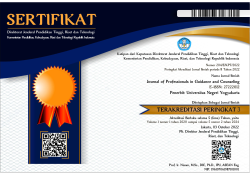The effectiveness of using educational cinema techniques to increase students' self-confidence: An experimental research
Downloads
This research is motivated by the problem of low self-confidence of students. The purpose of this study was to test the effectiveness of educational cinema techniques as a medium to increase students' low self-esteem. The research design used pre experimental research with one group pretest and posttest design. The research subjects were 16 students of class VIII SMPN 6 Malang, the subjects were selected using purposive sampling technique. Data collection used (1) self-confidence scale; (2) experimental guidelines and (3) observation guidelines. Data analysis used descriptive and statistical analysis (Wilcoxon signed rank test). The results of data analysis produce that H0 is rejected and H1 is accepted, this means that there is a significant increase in student self-confidence after being given educational cinema techniques. The findings of the study show that there are differences in the improvement of students 'self-confidence between before (pretest) and after (posttest) being given educational cinema techniques, thus the results of the study concluded that educational cinema techniques were effective in increasing students' self-confidence.
Downloads
Alexander, M., & Waxman, D. (2000). Cinemeducation: Teaching family Systems through the Movies. Families, Systems & Health, 18(4), 455–466.
Andiwatir, A., & Khakim, A. (2019). Analisis Perilaku Menyontek dan Rancangan Perubahannya pada Siswa SMP ( Analysis of Cheating Behavior and Change Design in Junior High School Students ) Info Artikel Abstrak Pendidikan sebagai sarana pembentuk intelektual dan moral diharapkan bebas dari b. Jurnal Psikologi Ilmiah, 11(2), 88–97.
Aprianti, R. (2013). Menumbuhkan Kepercayaan Diri Melalui Kegiatan Bercerita. Indeks.
Arroio, A. (2007). The Role of Cinema Into Science Education. Problem of Education In The 21st Century, 1.
Blasco, P. G., & Moreto, G. (2012). Teaching Empathy through Movies : Reaching Learners ' Affective Domain in Teaching Empathy through Movies : Reaching Learners ' Affective Domain in Medical Education. Journal of Education and Learning, 1(1). https://doi.org/10.5539/jel.v1n1p22
Brown, S., Kirkpatrick, M., Mangum, D., & Avery, J. (2008). A Review of Narrative Pedagogy Strategies to Transform Traditional Nursing Education. Journal of Nursing Education, 479(2), 283-286.
Chambers, J., & College, E. (2019). Exploring co-creation in practical film education from primary school to postgraduate study : Theoretical and auto-ethnographic perspectives upon teaching film practice. Film Education Journal, 2, 27–47.
Cohen, L., Manion, L., & Morrison, K. (2007). Research Methods in Education. Sixth edition. Routledge Taylor & Francis Group.
Creswell, J. W. (2012). Educational Research: Planning, Conducting, and Evaluating Quantitative and Qualitative Research (Fourth Edition). Pearson.
Diez, K., Pleban, F., & Wood, R. (2005). Lights, Camera, Action: Integrating Popular Filmin the Health Classroom. Journal of School Health 72 (7), 72(7), 271–275.
Fatchurahman, M., & Pratikno, H. (2012). Demokratis dan Kenakalan Remaja. Persona: Jurnal Psikologi Indonesia, 1(2).
Hidayah, N. (2014). Keefektifan Teknik Sinema Edukasi untuk Meningkatkan Sikap Asertif Siswa MTs Negeri Malang I. Jurnal Pendidikan Dan Pembelajaran, 21(2), 165–172.
Hurlock, E. (2006). Psikologi Perkembangan: Suatu Pendekatan Sepanjang Rentang Kehidupan. Erlangga.
Jencius, M. (2011). Movie Magic and Mental Health. Counselling Today Journal., 53, 11–22.
Lautser, P. (2001). Psikologi Kepribadian. PT. Bumi Aksara.
Lodico, M., Spaulding, D., & Voegtle, K. (2006). Methods in Educational Research: From Theory to Practice. John Wiley & Sons, Inc.
Maharani, I., Fridani, L., & Akbar, Z. (2019). Efektifitas Penggunaan Media Film Bertema Layanan Informasi Bimbingan Klasikal. Jurnal Ilmiah Kependidikan, 6(2), 135–146.
Munaji, Y. (2008). Media pembelajaran sebuah pendekatan baru. Gunung Persada Press.
Nugraheni, W. (2004). Efektivitas Cuplikan Sinema Edukasi Untuk Meningkatkan Keterampilan Pemecahan Masalah Bagi Siswa SMP. Jurnal Universitas Negeri Malang. JPPI. Jilid 6, Nomor 9.
Oh, J., Kang, J., & De Gagne, J. (2012). Learning concepts of cinenurducation: an integrative review. Nurse Education Today, 32(8), 914–919.
Pradita, P. (2014). Stopminder dan Grogi: Saatnya Tampil Beda dan Percaya Diri. Araska.
Ragil, E., Ariyanto, R. D., Ratnawati, V., Ningsih, R., & Valdino, D. R. (2019). Keefektifan Teknik Modeling Berbasis Sinema Edukasi untuk. Jurnal Nusantara of Research, 6(1), 50–59.
Soidhermer, A. (2000). The Life Stories of Children and Adolescents Using Commercial Films as Teaching Aids, Academic Psychiatry. University of Medicane.
Surya, H. (2007). Kepercayaaan Diri Itu Penting. Gramedia.
Wolz, B. (2004). E-motion Picture A Movie Lover's Guide To Healing and Transformation. Glenbridge Publishing Ltd.
Wu, A. (2008). Applying Cinema Therapy with Adolescent and a Cinema Therapy Workshop. California State University.
Yakar, H. G. (2018). Use of the Movies in the Turkish Language and Literature Education in Turkey. Journal of Education and Learning, 7(3), 41–55. https://doi.org/10.5539/jel.v7n3p41
Yudhianto, A. (2012). Pengembangan Media Permainan Simulasi Peta Pemburu Bajak Laut Untuk Meningkatkan Kepercayaan Diri Siswa Kelas VII SMPNU Syamsuddin Malang. In Malang: Universitas Negeri Malang.
Zaudere, C., & Ganzer, C. (2011). Cinematic Technology: the Role of Visual Learning. Nurse Educator, 36(2).
Zauderer, C., & Ganzer, C. (2011). Cinematic Technology: the Role of Visual Learning. Nurse Educator, 36(2), 76–79.
 | ProGCouns: Professional Guidance and Counseling Journal is licensed under a Creative Commons Attribution-ShareAlike 4.0 International License. |















